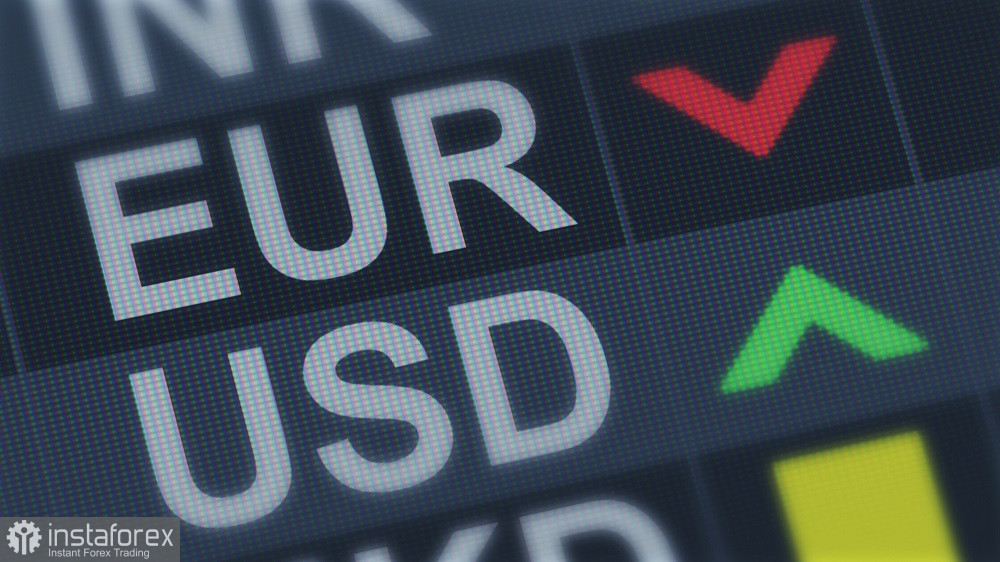The EUR/USD pair cannot determine the direction of its movement. The bullish momentum, triggered by the US inflation report, is gradually fading. The bulls were unable to settle above the resistance level of 1.0950 (the upper line of the Bollinger Bands indicator on the daily chart), afterwards the bears took the initiative. However, they also failed to demonstrate any impressive successes: a local low was recorded at the level of 1.0853.

In general, the pair is in a deadlock. The bulls are trying to keep the price above the 1.0900 target, while the bears try to pull it towards the 1.0800 level. This reflects how indecisive traders are in the EUR/USD market. The contradictory fundamental background forces traders to take profits near support/resistance levels.
It is worth acknowledging that the US dollar is the driving force behind the pair's growth, which is getting weaker as buyers push the pair into the 1.0900 area, updating a 3-month high. However, the euro also played a role in this process, primarily thanks to the European Central Bank, whose representatives have recently tightened their rhetoric. Not long ago, the market was confident that the ECB had completed its tightening cycle. At the last meeting, the central bank indicated its readiness to keep rates at the current level for an extended period, but did not announce further steps towards tightening. It seemed like the question was closed and not subject to discussion. However, recent statements by policymakers brought the ECB back into play. Several Governing Council members, including Robert Holzmann, Martins Kazaks, and Pierre Wunsch, said that the ECB could resume the rate hike cycle, and it might happen very soon.
On Wednesday, ECB President Christine Lagarde joined this "hawkish choir." Although she did not announce rate hikes or provide corresponding hints, the tone of her speech was hawkish. "This is not the time to start declaring victory," Lagarde said in a speech. "We need to remain focused on bringing inflation back to our target, and not rush to premature conclusions based on short-term developments." She added that price growth could accelerate in the coming months, so the ECB needs to remain vigilant about risks.
Bundesbank President Joachim Nagel acknowledged that ECB policy "works," but he also noted that inflation has not been defeated yet and could accelerate in the coming months.
The statements by Lagarde and Nagel should be considered in conjunction with remarks from their colleagues who have recently been winding up traders with their hawkish comments. The thesis that "it is too early to put a dot in tightening monetary policy" is increasingly voiced, despite the fact that the latest report on the eurozone Consumer Price Index reflected a slowdown in both overall and core inflation. Nevertheless, the fact remains: the ECB maintains a hawkish stance, and if inflation accelerates again in November, hawkish expectations regarding the ECB's future course of actions will significantly increase.
The European PMIs also provided support. Although, frankly, there is no particular reason for optimism here— all indicators remained in the contraction zone, below the 50-point mark (French PMIs were even worse than expected). However, German and pan-European indicators, firstly, entered the "green zone," and secondly, demonstrated positive dynamics. For example, Germany's PMI reached 42.3 in November (forecasting a rise to 41.0), compared to 40.8 in October. The Services PMI rose to 48.7 (with a forecast of 48.3). The pan-European Manufacturing PMI also entered the green zone, rising to 43.8 points (in the services sector - 48.2).
In turn, the dollar is under background pressure after the release of U.S. inflation data for October. However, this fundamental factor has already been played out—traders are confident that the Federal Reserve will not raise rates further in the current cycle but doubt that the Fed will resort to tightening the monetary policy in the next six months. Fed officials themselves maintain a "moderately hawkish" stance, assuring markets that the rate will remain at the current level "as long as necessary." This position keeps the greenback afloat, preventing the bulls from making a significant upward move toward the 1.1000 level.
Given the mixed fundamental background, we can assume that in the medium term, the pair will trade in a relatively wide price range between the lower and upper lines of the Bollinger Bands indicator on the 4-hour chart, i.e., between 1.0870 and 1.0950.
 English
English 
 Русский
Русский Bahasa Indonesia
Bahasa Indonesia Bahasa Malay
Bahasa Malay ไทย
ไทย Español
Español Deutsch
Deutsch Български
Български Français
Français Tiếng Việt
Tiếng Việt 中文
中文 বাংলা
বাংলা हिन्दी
हिन्दी Čeština
Čeština Українська
Українська Română
Română

